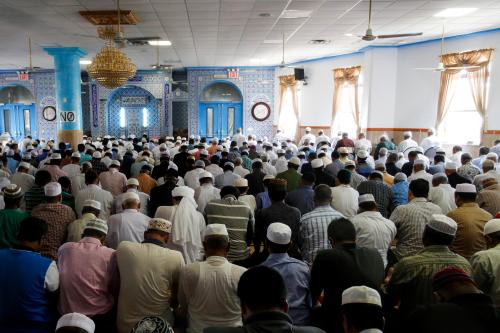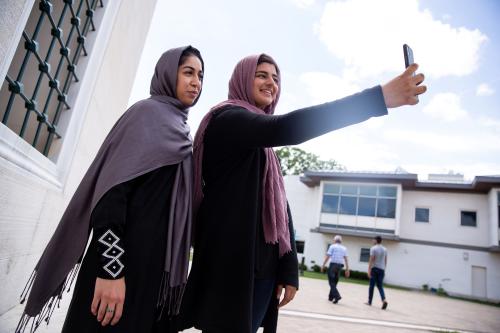Editors’ Note: In response to a Washington Post article criticizing “World Hijab Day,” Shadi Hamid writes that Muslims should openly debate the headscarf. This post originally appeared on Parlio.
Muslims need to be able to freely and openly debate the headscarf, or hijab. It’s certainly true, as Asra Nomani argues, that the idealization of hijab can put women who choose not to wear it in a challenging position. So, yes, speaking as a Muslim-American, if I had a daughter, I’d want her to be able to not cover her hair and not have to worry about being judged by her peers as somehow less religious or “chaste.” But this doesn’t change the fact that just as women should be free and empowered to choose not to wear hijab, they must also be free and empowered to wear it, if that’s what they want.
This is why it’s hard for me to understand why we need to put quotes around the word “choice.” Here in the United States, every single hijabi woman I know has chosen to wear it voluntarily, sometimes to the dismay, or even outright opposition, of friends and family. While there are countries like Saudi Arabia or Iran where hijab is mandated, in countries like, say, Turkey or Morocco, there’s no evidence I’ve seen that suggests that a large number of women are forced against their will to wear the headscarf by a parent or spouse. So it really depends on which countries we’re talking about. (Of course, in those cases where women are forced by their families, communities and civil society organizations, whether in Western or Muslim-majority countries, should speak out unequivocally and take action).
[J]ust as Muslims have the right to argue that the hijab is not religiously mandated, they should also have the right to argue that it is religiously mandated.
If Nomani and Hala Arafa’s Washington Post article was merely offering the view that the headscarf isn’t Islamically mandated, then that’s great. (It goes both ways though: just as Muslims have the right to argue that the hijab is not religiously mandated, they should also have the right to argue that it is religiously mandated).Muslims need to feel comfortable debating sensitive issues like this in public forums. I certainly agree with Nomani that people shouldn’t feel afraid to object to the notion that hijab is fard (obligatory). This, though, doesn’t mean casting the choices of the hundreds of millions of women who have worn the headscarf as somehow invalid, irrational, wrong, or backwards. In her post here, Nomani argues for example that the headscarf is a symbol of a “dangerous purity culture, obsessed with honor and virginity.” This would seem to suggest that anyone who chooses to wear it is somehow encouraging “a dangerous purity culture, obsessed with honor and virginity.”
Just as conservatives argue that the opinion that hijab is not obligatory is simply illegitimate and worthy of scorn, we need to be careful about doing the reverse. Nomani and Arafa write that “in exploring the ‘hijab,’ [those in universities and the media] are not exploring Islam, but rather the ideology of political Islam as practiced by the mullahs, or clerics, of Iran and Saudi Arabia, the Taliban in Afghanistan and the Islamic State.” This is not quite correct. For better or worse, all four Sunni madhabs (schools of law) consider covering the hair to be obligatory by ijma’, or consensus, regardless of geographic context. We don’t have to like this (and perhaps one day there will be more dissenting voices like Khaled Abou El Fadl), but we can’t ignore or dismiss it either. Legal debates aside, there are endless millions of Muslim women who believe that covering their hair is religiously mandated, so, for them, it is inextricably tied to Islam and to their own personal relationship to God. To insist otherwise is to deny the agency, autonomy, and choice of these Muslim women.
I also have some concerns about how Nomani and Arafa link the wearing of the headscarf to the rise of Islamism. The idea that the hijab is some modern Islamist creation is not correct. While it is true that majorities of women, particularly in urban centers, did not cover their hair in the 1950s or 60s, it is more accurate to see this several decades-long period, during the heyday of secular Arab nationalism, as exceptional in the broader sweep of history. For instance, in the pre-modern era, the vast majority of women covered their hair throughout the Middle East (and even this may be an understatement).
It is also hard to blame Islamists for hijab, since the “Islamic revival” in the Arab world preceded the rise of Islamist parties, and not the other way around. I discuss this at length in my book Temptations of Power, but here a few relevant data points. In Jordan, the “secular” government started getting religion – by, for example, incorporating the religious obligation of zakat into the tax system and Islamizing television programming – before there was a single Islamist in parliament. One of the most ambitious efforts in recent decades to reconcile national law with sharia occurred under the “secular” President Anwar el-Sadat when the Muslim Brotherhood in Egypt controlled less than 1 percent of parliament. Sadat’s sharia committees receive little attention, but it’s a fascinating episode in recent Egyptian history. In short, much of the Islamic revival of 1970s and 80s was grassroots and organic (as evidenced by the fact that, even where Saudi Arabia’s influence was marginal, as in Turkey, we see similar trends). With democratic openings in Jordan and Egypt in the 1980s, Islamist parties could ride society’s growing religiosity to electoral success. What this means is that the initial rise of Islamist parties was more the consequence rather than the cause of the Arab religious revival.
Meanwhile, in Egypt today, some of the most vociferous anti-Islamist voices – many of whom self-define as “liberal” – wear the headscarf and do so proudly. I imagine they’d find being called instruments of Islamism somewhat odd.
It is also worth noting that just as headscarf can be forced, so too can not wearing it. Tunisia and Turkey saw decades of forced secularization, where the headscarf was not only stigmatized and belittled as backwards but also even banned in state and public institutions. Presumably, the many women who still chose to wear the headscarf in these circumstances were doing so at considerable risk. In Tunisia, to wear the hijab meant to put yourself under suspicion of being a member or supporter of the then-banned Islamist movement, Ennahda. (Few have made the argument that hijab is an Islamist creation with more enthusiasm than certain secular dictatorships). Up until just a couple years ago, wearing the headscarf in Turkey meant that you couldn’t go to university in your own country or work as a doctor in a state hospital. Despite this, large numbers, and even majorities, chose to cover their hair.
Finally, there is a way of phrasing and framing the debate that I think we would all do well to avoid. For example, Nomani and Arafa write about growing up “in modern Muslim families.” This, again, would seem to suggest that women who choose to cover their hair are somehow less modern. What, I would ask, is intrinsically “modern” about not covering one’s hair?
The Brookings Institution is committed to quality, independence, and impact.
We are supported by a diverse array of funders. In line with our values and policies, each Brookings publication represents the sole views of its author(s).







Commentary
The right to choose to wear (or not) hijab
January 19, 2016